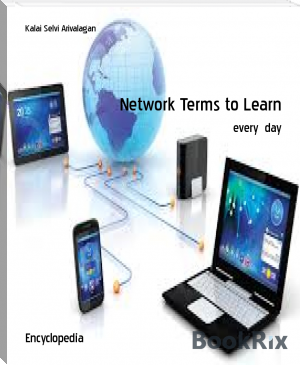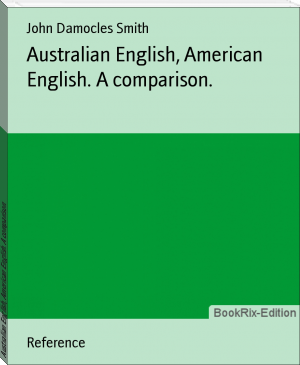Network Terms to Learn - Kalai Selvi Arivalagan (best love novels of all time .TXT) 📗

- Author: Kalai Selvi Arivalagan
Book online «Network Terms to Learn - Kalai Selvi Arivalagan (best love novels of all time .TXT) 📗». Author Kalai Selvi Arivalagan
Artificial Intelligence Robot
Artificial Intelligence Robot or AIBO is a name for a Sony product developed as a robotic pet. Multiple instances of this product line are available in the United States, although they come with price tags of up to several thousand dollars. The AIBO uses an Open-R modular platform to create a life-like interface including voice recognition, machine learning and the ability to respond to stimulus.
Candidate Key
A candidate key is a column, or set of columns, in a table that can uniquely identify any database record without referring to any other data. Each table may have one or more candidate keys, but one candidate key is unique, and it is called the primary key. This is usually the best among the candidate keys to use for identification. When a key is composed of more than one column, it is known as a composite key.
Martech
The term "martech"is a portmanteau combining the terms "marketing" and "technology." As such, martech represents the intersection of marketing and technology in today's highly digital business world. Any type of technology that has a bearing on marketing operations can be called "martech" whether it is a part of an analysis platform, a device-facing benchmark tool, or any other type of digital or high-tech resource.
iJack
iJack refers to personal electronic information or identity theft. Victims who have been iJacked can experience many devastating effects, but iJacking has become increasingly difficult to prosecute due to lack of electronic trail evidence when pursing cyber criminals.
Blob Storage
Blob storage is a feature in Microsoft Azure that lets developers store unstructured data in Microsoft's cloud platform. This data can be accessed from anywhere in the world and can include audio, video and text. Blobs are grouped into "containers" that are tied to user accounts. Blobs can be manipulated with .NET code.
Computational Neuroscience
Computational neuroscience is the science of studying brain function with computer science modeling, and looking at all of the activity of the human brain through the lens of computer science. Scientists engaged in computational neuroscience might build models to understand how neurons, axons and dendrites work. The field of computational neuroscience blends aspects of computer science and electrical engineering with traditional studies of biology.Computational neuroscience is also known as theoretical neuroscience.
Node
A node is a point of intersection/connection within a network. In an environment where all devices are accessible through the network, these devices are all considered nodes. The concept of nodes works on several levels, but the big-picture view defines nodes as the major centers through which Internet traffic is typically routed. This usage is somewhat confusing, as these same Internet nodes are also referred to as Internet hubs.
Nearable
A nearable is a device belonging to an emerging class of technology: small pieces of hardware that can track nearby smartphone device behavior or other similar types of user events, or the proximity of devices. A nearable is also known as a nearable device.
Swarm Intelligence
Swarm intelligence is the idea of coordinating massive numbers of individual technology entities to work together. It is a fundamental concept in IT that has been useful and interesting, as well as a bit threatening, throughout the development of modern technological progress.
Voodoo Programming
Voodoo programming refers to the practice of coding according to superstition, guesses, or anything other than logic. Voodoo programming is a rather broad term for situations where a programmer uses a piece of code without truly understanding how it works. This programming technique may also be called wizardry, sorcery or black magic, and its practitioners may be referred to as witch doctors.
Physical Neural Network
A physical neural network is a type of neural network in which the activity of individual artificial neurons is modeled, not by a software program, but by actual physical materials. These systems are based much more concretely on the biophysical processes of the human brain, and are a very specific and sophisticated type of neural network that is not extremely common in the tech world.
Deep Q-Networks
Deep Q Networks (DQN) are neural networks (and/or related tools) that utilize deep Q learning in order to provide models such as the simulation of intelligent video game play. Rather than being a specific name for a specific neural network build, Deep Q Networks may be composed of convolutional neural networks and other structures that use specific methods to learn about various processes.
Q-learning
Q-learning is a term for an algorithm structure representing model-free reinforcement learning. By evaluating policy and using stochastic modeling, Q-learning finds the best path forward in a Markov decision process.
Neuroimaging
Neuroimaging is defined as the use of "techniques to either directly or indirectly image the structure, function or pharmacology of the nervous system." It’s a general way to advance neuroscience through principles of observation and direct application. It comes in many forms, from digital neural networks to direct mechanical interactive technologies.
Onboard Intelligence
Onboard intelligence is a term used to refer to artificial intelligence that's built into a device design, rather than outsourced to remote technology.
Loop Variable
In computer programming, a loop variable is a variable that is set in order to execute some iterations of a "for" loop or other live structure. A loop variable is a classical fixture in programming that helps computers to handle repeated instructions.
Change Management
Change management is an IT services management (ITSM) strategy in which a systematic approach ensures the efficient and seamless flow of change in an organization's IT infrastructure. Change management helps all involved parties, including both individuals and teams, to move from a current state to the next desired state. Change management also helps to minimize the impact of related incidents on service. Change is prevalent in any IT organization and it may arise reactively in response to problems or be externally imposed. Change management is also a project management process where change requires formal adherence to established policies.
Password Sniffer
A password sniffer is a software application that scans and records passwords that are used or broadcasted on a computer or network interface. It listens to all incoming and outgoing network traffic and records any instance of a data packet that contains a password.
Aspect-Oriented Programming
Aspect-oriented programming (AOP) is a programming paradigm that isolates the supporting functions from the main program’s business logic. AOP includes programming methods and tools supporting modularization of concerns at the source code level, but it may also refer to the entire software engineering discipline.
Proximity Sensor
A proximity sensor is an intelligent sensor that can detect the presence of objects within its vicinity without any actual physical contact. Proximity sensors, which are often used in collision warning and collision avoidance systems, have the ability to detect the presence of a target within a defined range. A proximity sensor might use, sound, light, infrared radiation (IR) or electromagnetic fields to detect a target.
Proximity sensors are commonly used in industrial applications and consumer robotics. They are also used in vehicles for detecting the physical closeness of other vehicles, as well as for parking-assist functions.
Term of the day - 11AI-Complete
AI-complete in IT is used to describe problems or outcomes that would rely on having a strong AI system in place – in other words, being able to put together a computer system that functions at as high a level as a human being. IT pros describe problems as “AI-complete” if they are too difficult to be achieved by the use of conventional algorithms.
Critical Path Method
The critical path method (CPM) is a step-by-step methodology, technique or algorithm for planning projects with numerous activities that involve complex, interdependent interactions. CPM is an important tool for project management because it identifies critical and non-critical tasks to prevent conflicts and bottlenecks. CPM is often applied to the analysis of a project network logic diagram to produce maximum practical efficiency.
Transmission Control Protocol/Internet Protocol
Transmission Control Protocol/Internet Protocol (TCP/IP) is the language a computer uses to access the Internet. It consists of a suite of protocols designed to establish a network of networks to provide a host with access to the Internet. TCP/IP is responsible for full-fledged data connectivity and transmitting the data end-to-end by providing other functions, including addressing, mapping and acknowledgment. TCP/IP contains four layers, which differ slightly from the OSI model. The technology is so common that you would rarely refer to somebody use the full name. In other words, in common usage the acronym is now the term itself.
RSA Encryption
RSA encryption is a public-key encryption technology developed by RSA Data Security. The RSA algorithm is based on the difficulty in factoring very large numbers. Based on this principle, the RSA encryption algorithm uses prime factorization as the trap door for encryption. Deducing an RSA key, therefore, takes a huge amount of time and processing power. RSA is the standard encryption method for important data, especially data that's transmitted over the Internet. RSA stands for the creators of the technique, Rivest, Shamir and Adelman.
Green Computing
Green computing is the environmentally responsible and eco-friendly use of computers and their resources. In broader terms, it is also defined as the study of designing, engineering, manufacturing, using and disposing of computing devices in a way that reduces their environmental impact.
Many IT manufacturers and vendors are continuously investing in designing energy-efficient computing devices, reducing the use of dangerous materials and encouraging the recyclability of digital devices. Green computing practices came into prominence in 1992, when the Environmental Protection Agency (EPA) launched the Energy Star program. Green computing is also known as green information technology (green IT).
Backscatter
Backscatter is a type of unsolicited spam/email message that is mistakenly directed to an email inbox. They are disguised as bounce messages, so that they are not filtered as spam by the email server. Backscatter is also known as outscatter, misdirected bounces, blowback and collateral spam.
Cache Cramming
Cache cramming is the process of making a computer execute a malicious file that would otherwise be restricted. It executes a small program in the browser cache that enables hackers/crackers to locally sniff open ports and/or access target computers.
Cable Jetting
Cable jetting involves putting a cable into a duct or conduit through the process of using compressed air to blow or push that cable into place.
Hash Chain
A hash chain is commonly defined as the repeated application of a cryptographic hash function to a given data asset. This type of hash cryptography can be extremely useful in some specific security setups. By providing a successive chain, hash chains make it harder for a snooping hacker to hijack a data asset through applying a single input.
Stream Cipher
A stream cipher is a method of encryption where a pseudorandom cipher digit stream is combined with plain text digits. This pseudorandom cipher digit stream is applied to each binary digit, one bit at a time. This method of encryption uses an infinite number of pseudorandom cipher digits per key. Stream cipher is also known as state cipher.
Egress Traffic
Egress traffic is any data or traffic bound for an external entity and passing through the edge router of the host





Comments (0)